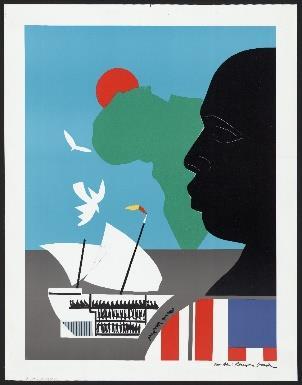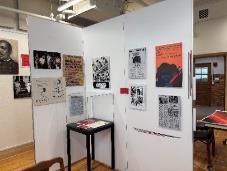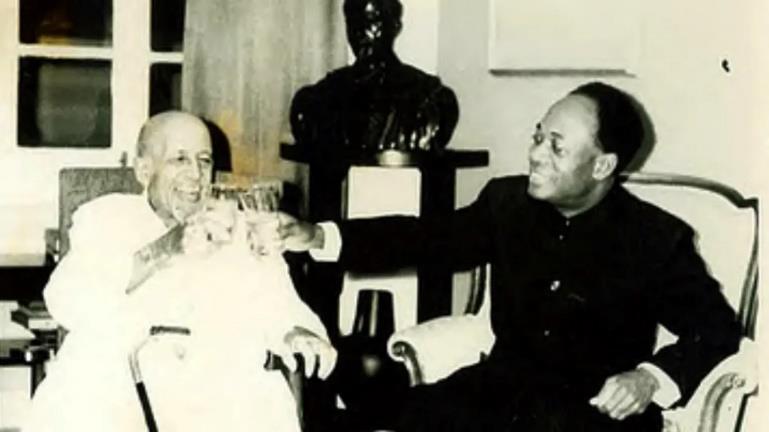ROOTS AND ROUTES: AFRICAN AMERICANS AND THE WORLD
Crispus Attucks Museum, 1140 MLK Jr. St., Indianapolis, February 17, 2025-June 1, 2025

“Roots”, by Romare Bearden, 1977
Romare Bearden Foundation / Licensed by VAGA at Artists Rights Society (ARS)
Image courtesy of Library of Congress
Curated by students in Indiana University Bloomington’s ASURE Discovery Lab Course
“The Black Freedom Struggle and the World”
Curators: Alex Lichtenstein
Indiana University, Bloomington
Elaine Adams, Jamilah Akou, Teagan Brown, Jesse Gonzales, Clara Graham, Bailee Hilpisch, Kennedy Hogue, Mutinta
Makala, Kyiah Onyon, Aysha Still, Alex Tryan, Taileaha Wilson, Olivia Young.
Designer: Anna J. Mort, Chicago
Printing: Kendall Reeves/Spectrum
Creative Group, Bloomington
With support from the Allen Whitehill
Clowes Charitable Foundation, IU Bloomington College of Arts and Sciences/ASURE Program, the IU Bloomington Institute for Advanced Study, IU University Collections at McCalla, and Robert Chester and the staff of the Crispus Attucks Museum, Indianapolis.
Roots and Routes: A Classroom Experiment
This exhibit is, above all, a collaborative project that grew from a “curatorial laboratory” established by history professor Alex Lichtenstein at Indiana University, Bloomington. As part of the College of Arts and Sciences ASURE program the Arts and Sciences Undergraduate Research Experience professor Lichtenstein worked with thirteen students to conceive of the exhibit, select the materials, create the layout, and write the wall text and labels. The students represented a wide range of interests and majors, from Fine Arts, to Criminal Justice, to East Asian Studies, to Neurosciences and more. Yet they all worked together to demonstrate how art, photography, music, and historical materials could bring to life the story of the African American freedom struggle in its fully international dimensions.

Curatorial notes on the exhibit
On February 4, 1794, in response to a massive slave uprising in the colony of Saint-Domingue (later known as Haiti), the revolutionary French National Convention abolished slavery on the island in what would be the first of many slave emancipations in the Atlantic World. A decade later, Haiti emerged as the first free Black Republic in the New World, inspiring enslaved people around the world, not least in the nearby United States. Denmark Vesey, who led a slave revolt in Charleston, South Carolina in 1822, looked to the Haitian Revolution as a model.
Two centuries later, in 1994, South Africans elected Nelson Mandela as President of their liberated nation, bringing to a close a global epoch of Black emancipation from slavery, colonialism, segregation, white supremacy, and apartheid. Since the 1950s, African Americans had been active participants in the global anti-apartheid movement, even while fighting for their own freedoms at home.
These two world-shaking moments of freedom the Haitian Revolution and the defeat of South African apartheid bracket the exhibit “Roots and Routes,” which takes viewers on a journey that traces the long history and trajectory of African American engagement with global affairs.
That engagement began, of course, the moment enslaved Africans first arrived on the shores of colonial Virginia in 1619. The persistent yearning for Africa as a lost homeland, as a sanctuary from white oppression, as a place of return and belonging, as a source of cultural pride and ethnic identity, as an anticolonial inspiration, and as a partner in solidarity against the racist white world has loomed large in the African American imagination. And it continues to do so today, over four hundred years later.
“Roots and Routes,” as the title suggests, considers both the origins of the worldwide Black embrace of an African homeland and the many journeys, both figurative and literal, that African Americans have made to the Continent and throughout its diaspora. Displaying artworks, photographs, historical documents, material culture, and music, the exhibit invites viewers to contemplate the rich diversity of the Black global presence. As the exhibit shows, at times this has manifested as a strong desire to go “back to Africa”, whether in the nineteenth century Colonization movement to Liberia, the Garveyite movement after World War I, or the exiles who left for Ghana and elsewhere during the Civil Rights and Black Power movements. At other moments, the African struggle for freedom against colonialism and apartheid has inspired the fight for freedom at home, among figures as diverse as W.E.B. Du Bois, Martin Luther
King, Jr., Malcolm X, and Stokely Carmichael. Finally, as “Roots and Routes” shows, global Black solidarity has extended well beyond African anticolonialism to encompass peoples elsewhere, including in Cuba, Vietnam, and Palestine.
We do not ask or expect visitors to agree with every expression of solidarity or global engagement displayed here. Instead, we hope the dynamic history illustrated in “Roots and Routes”, from the slave revolt that made the Haitian Revolution to the global solidarity that buoyed the anti-apartheid struggle, conveys the worldwide importance of the African American freedom struggle across the ages.

W.E.B. Du Bois and Kwame Nkrumah, Accra, Ghana, Feb. 23, 1963
Courtesy of Special Collections and University Archives, University of Massachusetts
The students in Dr. Alex Lichtenstein’s Indiana University, Bloomington’s Fall 2024 undergraduate research class on “The Black Freedom Struggle and the World” prepared extra curatorial information and details for ten of the displays.
Their work can be found here:



